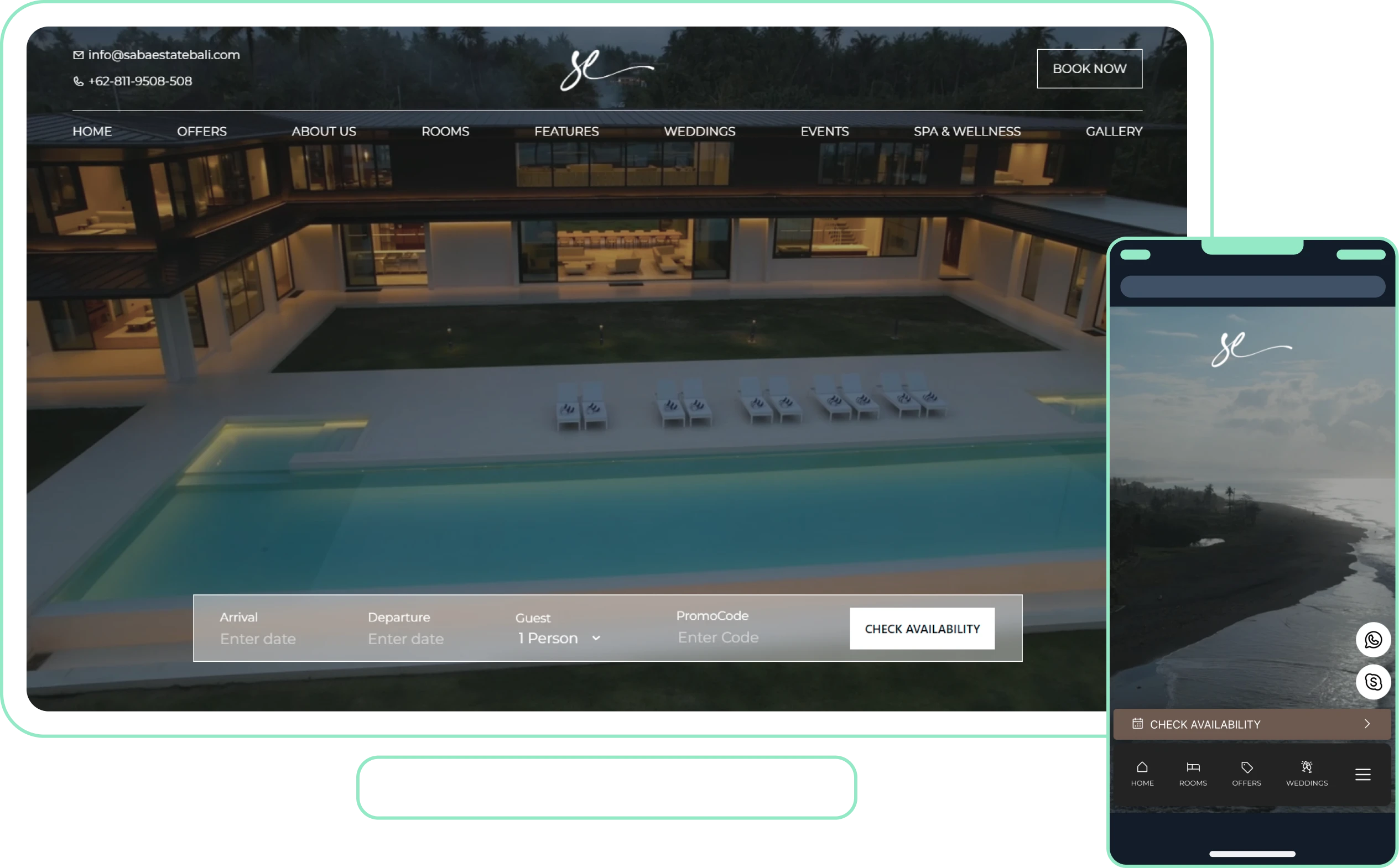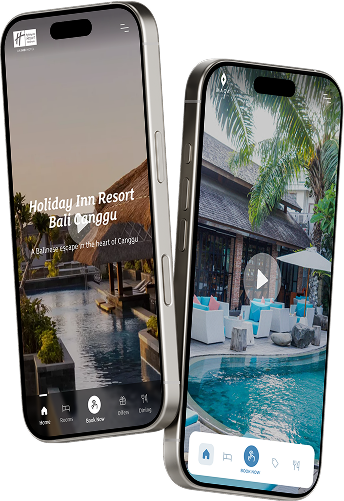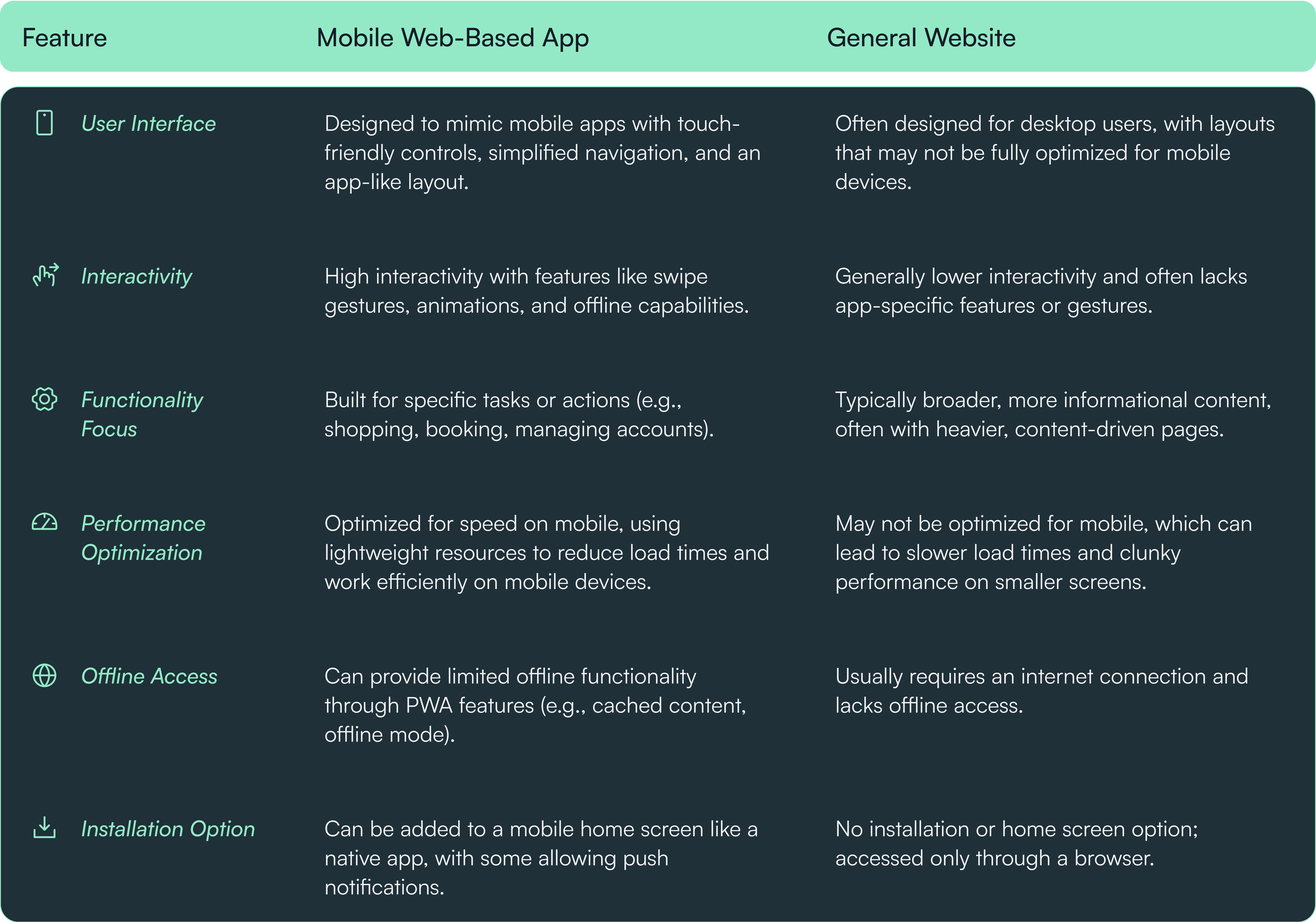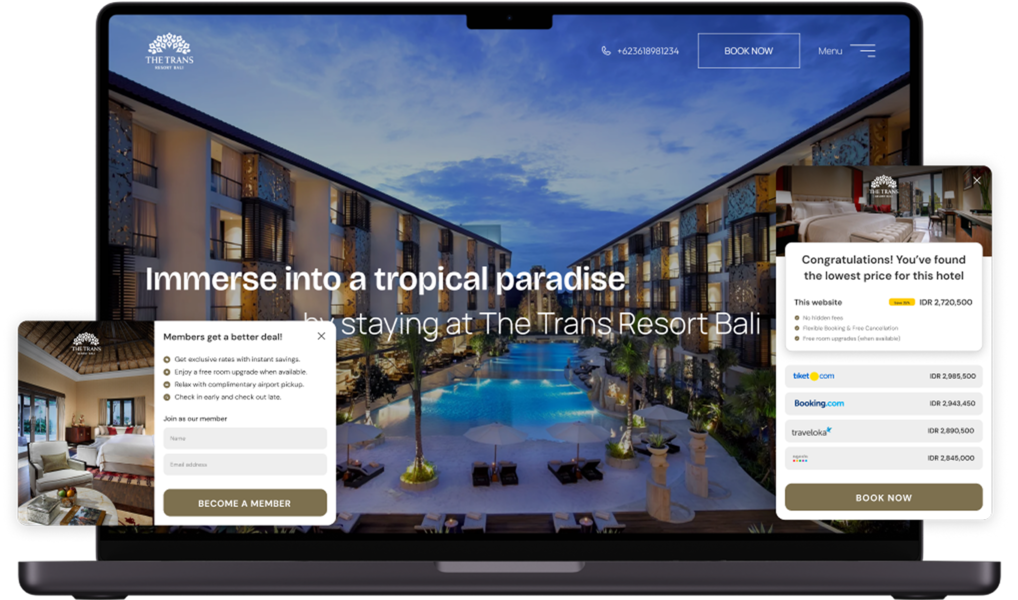Website Development & Management
Custom website development and management optimized for Google systems, with user-friendly UI/UX design to enhance user experience and drive direct bookings.


Responsive Design
What Is Responsive Design and
How Does It Work?
Responsive design is a web design approach that enables a website to adapt its layout and content dynamically based on the screen size, resolution, and orientation of the device being used. This approach aims to provide an optimal viewing and interaction experience for users across a wide range of devices, including desktops, tablets, and smartphones.
Responsive design enables a website to automatically adjust its layout and features to suit different devices, providing a consistent, optimized user experience whether users visit on a desktop, tablet, or mobile device.

Key Elements of responsive web design
Fluid Grids
Instead of using fixed-size layouts, responsive websites use fluid grids that allow elements to resize proportionally. This ensures that content maintains its structure and readability on screens of all sizes.
Flexible Images and Media
Images and other media elements adjust or scale according to the screen size, ensuring they are neither too large nor too small for the device.
Mobile-Friendly Navigation
Responsive sites often include user-friendly, adaptive navigation, like collapsible or dropdown menus, which make it easy to access site content on smaller screens.
Optimized Content Display
Text size, padding, and spacing adjust automatically to ensure that content is easy to read and navigate, regardless of screen size. This improves accessibility and readability for all users.
Why Responsive Design is crucial for modern website
Responsive design is essential for modern websites because it ensures a smooth, enjoyable experience for users on any device, whether they’re on a desktop, tablet, or smartphone. Here are 6 reasons why Responsive Design in crucial for modern website development :
Enhanced User Experience
Responsive design ensures users have a positive experience, whether they’re on a phone, tablet, or desktop. By automatically adjusting layout and content, it makes navigation and readability effortless, leading to higher satisfaction and engagement.
Broader Audience Reach
With the explosive growth of mobile internet usage, a responsive website can reach a broader audience by providing an optimized experience for mobile and tablet users, not just desktop users.
Better SEO Performance
Google and other search engines prioritize mobile-friendly websites in their rankings. Responsive design is a key factor in achieving mobile-friendly status, leading to better search engine visibility and higher rankings.
Lower Maintenance Costs
With one responsive design, there’s no need to manage separate websites or apps for different devices. This single-codebase approach simplifies updates, reduces maintenance time, and cuts costs, making it highly efficient.
Higher Conversion Rates
A consistent and seamless experience across devices encourages users to stay longer, browse more, and ultimately take desired actions, like signing up or making a purchase. This consistency can significantly boost conversion rates.
Future-Proof Adaptability
Responsive design prepares your website for new devices and screen sizes that may emerge. As technology evolves, a responsive design can adjust to meet future needs without requiring a complete redesign.
Page Speed Optimization
What Is Page Speed Optimization and
How Does It Work?
Page speed optimization in website development is the process of improving how quickly a website loads and responds to user interactions. A fast-loading website enhances the user experience by reducing wait times, which encourages visitors to stay on the page and engage with its content. Page speed is also a critical factor in search engine rankings, as search engines like Google prioritize faster sites, making them more likely to appear higher in search results.
Why Page Speed Optimization matters
Page speed is essential for both user satisfaction and SEO. Faster websites retain visitors more effectively, reducing bounce rates and increasing the likelihood of conversions or user engagement. Additionally, since Google uses page speed as a ranking factor, a well-optimized website is more likely to appear higher in search results, attracting more organic traffic. Ultimately, page speed optimization is crucial in delivering a smooth, efficient user experience that can significantly impact the success of a website.

6 Key Techniques to Achieve Optimal Page Speed
Minimize HTTP Requests
Reduce the number of elements (images, scripts, and stylesheets) that the browser must load by combining files, removing unnecessary elements, and simplifying the design. Fewer requests mean faster load times.
Optimize Images
Compress images without sacrificing quality, use appropriate formats (like WebP for web images), and set responsive sizes. This significantly reduces the amount of data that needs to be loaded, speeding up the page.
Enable Browser Caching
Use browser caching to store static resources on the user’s device, allowing frequently accessed elements like images and scripts to load instantly on return visits rather than reloading from the server.
Minify and Compress Code
Remove unnecessary characters and spaces from HTML, CSS, and JavaScript files and compress them to reduce their size. Smaller file sizes mean they load faster, improving overall page speed.
Implement a Content Delivery Network (CDN)
Distribute website content across servers in multiple geographic locations, so users load the site from a server nearest to them. This reduces latency, especially for international users, resulting in faster load times.
Use Lazy Loading for Images and Videos
Delay loading non-essential images and videos until they are needed (e.g., when a user scrolls to that part of the page). This reduces the initial page load time, making the visible content load faster and improving the user experience.
Mobile Web Apps
What Is Mobile Web Apps and
How Does It Work?
A mobile web-based app website is essentially a website that looks and functions like a mobile app when accessed through a mobile device’s web browser. Instead of requiring users to download it from an app store, users can open it by simply typing in the web address, like they would for any other website. These websites are designed to be responsive, meaning they adjust automatically to fit the smaller screens of mobile devices, making them easy to use on smartphones and tablets.

Difference between Mobile Web-based Apps and General Websites

Integrated Tools System
What Is Integrated Tools System and
How Does It Work?
A tools-integrated system website is a website that incorporates various tools, applications, or third-party services to provide users with a seamless, centralized platform for performing specific tasks or accessing information. These tools are often integrated to work together, enabling users to perform multiple functions without needing to leave the website. This approach is common for business, educational, or productivity websites where users need access to several resources, like project management, communication, data analysis, and more.
Why should a website incorporate a tools-integrated system?
A website should incorporate a tools-integrated system to enhance user experience and efficiency by centralizing various functionalities in one platform. This integration allows users to perform multiple tasks without switching between applications, ensuring data consistency and fostering collaboration. It streamlines workflows, boosts productivity, and provides valuable insights through centralized management, making it essential for modern websites.

How a Tools-Integrated System Website Works
Centralized Access to Multiple Tools
The website acts as a central hub where users can access different tools and resources, such as data dashboards, file-sharing applications, or collaborative workspaces. These tools might be developed in-house or integrated from third-party providers through APIs.
Data Integration and Synchronization
To ensure a smooth experience, the website is designed to synchronize data between various tools. For instance, data entered in one tool (like a task list) can automatically update related tools (like a calendar or project tracker), creating a cohesive, real-time system where all tools work with the same data.
APIs for Communication Between Tools
APIs (Application Programming Interfaces) play a key role in connecting different tools within the system. APIs allow the website to request, retrieve, and send data between different applications. For example, a CRM (Customer Relationship Management) tool can be integrated with a communication tool to pull up client information during a chat or call.
User Authentication and Role Management
A tools-integrated website often uses a single sign-on (SSO) system, so users only need to log in once to access all integrated tools securely. Role-based access control can restrict which tools or data a user can access based on their role or permissions, adding a layer of security and customization to the experience.
User Interface Design for Seamless Experience
To create a cohesive user experience, the website often has a unified user interface (UI) that integrates various tools in a consistent, accessible way. This means users can access different tools through a common navigation structure and a visually consistent interface, so switching between tools feels natural and straightforward.
Real-Time Data Updates and Notifications
Many tools-integrated system websites use real-time data updates and notifications. This ensures that users see the latest information without needing to refresh the page or switch tools. For example, a notification system might alert users of updates in a chat tool, project management tool, or reporting dashboard as soon as they happen.
Still not sure to choose us?
See how we’ve brought our clients' visions to life! Check out our portfolio and see the results for yourself.
KOMINFO TDPSE registered no. 016992.01/DJAI.PSE/01/2025
©2025 Mindimedia. All Rights Reserved.

